What's the geography like in Nicaragua in general? Does Nicaragua have mountains, volcanoes, beaches, lakes, waterfalls, or rainforests?
Sendy Tijerino
Nicaragua is located in the center of America,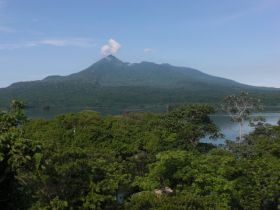 in an area that divides the Pacific Ocean and Caribbean Sea. This interesting location causes Nicaragua to have great biodiversity and also mountains, volcanoes, beaches, lakes and other features. Nicaragua is one of the few countries where people will find this variety so close together.
in an area that divides the Pacific Ocean and Caribbean Sea. This interesting location causes Nicaragua to have great biodiversity and also mountains, volcanoes, beaches, lakes and other features. Nicaragua is one of the few countries where people will find this variety so close together.
 in an area that divides the Pacific Ocean and Caribbean Sea. This interesting location causes Nicaragua to have great biodiversity and also mountains, volcanoes, beaches, lakes and other features. Nicaragua is one of the few countries where people will find this variety so close together.
in an area that divides the Pacific Ocean and Caribbean Sea. This interesting location causes Nicaragua to have great biodiversity and also mountains, volcanoes, beaches, lakes and other features. Nicaragua is one of the few countries where people will find this variety so close together. For example, the first picture shows some of the geography of Nicaragua, with a lake, mountains, and jungle in the...
Nicaragua is located in the center of America, in an area that divides the Pacific Ocean and Caribbean Sea. This interesting location causes Nicaragua to have great biodiversity and also mountains, volcanoes, beaches, lakes and other features. Nicaragua is one of the few countries where people will find this variety so close together.
in an area that divides the Pacific Ocean and Caribbean Sea. This interesting location causes Nicaragua to have great biodiversity and also mountains, volcanoes, beaches, lakes and other features. Nicaragua is one of the few countries where people will find this variety so close together.
 in an area that divides the Pacific Ocean and Caribbean Sea. This interesting location causes Nicaragua to have great biodiversity and also mountains, volcanoes, beaches, lakes and other features. Nicaragua is one of the few countries where people will find this variety so close together.
in an area that divides the Pacific Ocean and Caribbean Sea. This interesting location causes Nicaragua to have great biodiversity and also mountains, volcanoes, beaches, lakes and other features. Nicaragua is one of the few countries where people will find this variety so close together. For example, the first picture shows some of the geography of Nicaragua, with a lake, mountains, and jungle in the same photograph.
Below, we have a beach in Nicaragua at sunset, with cliffs, and San Cristobal Volcano
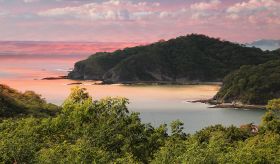
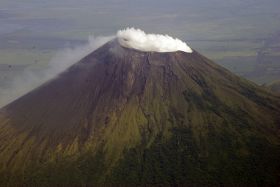
Posted July 2, 2014
Lucy Valenti - Liv Nicaragua
Nicaragua is a very geographically diverse 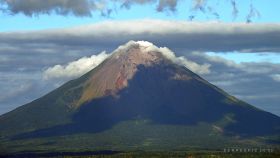 country, even though we do not have very high peaks compared to other places like Guatemala. We do, however, have mountains, which have the advantage of being a little bit cooler the higher you go.
country, even though we do not have very high peaks compared to other places like Guatemala. We do, however, have mountains, which have the advantage of being a little bit cooler the higher you go.
In the Pacific coast of Nicaragua we have the volcanic mountain range, which starts in the northern part of the country and ends at the lake, in Ometepe Island, which was formed by two volcanoes. Most of the volanoes are dormant,...
 country, even though we do not have very high peaks compared to other places like Guatemala. We do, however, have mountains, which have the advantage of being a little bit cooler the higher you go.
country, even though we do not have very high peaks compared to other places like Guatemala. We do, however, have mountains, which have the advantage of being a little bit cooler the higher you go.In the Pacific coast of Nicaragua we have the volcanic mountain range, which starts in the northern part of the country and ends at the lake, in Ometepe Island, which was formed by two volcanoes. Most of the volanoes are dormant,...
Nicaragua is a very geographically diverse  country, even though we do not have very high peaks compared to other places like Guatemala. We do, however, have mountains, which have the advantage of being a little bit cooler the higher you go.
country, even though we do not have very high peaks compared to other places like Guatemala. We do, however, have mountains, which have the advantage of being a little bit cooler the higher you go.
In the Pacific coast of Nicaragua we have the volcanic mountain range, which starts in the northern part of the country and ends at the lake, in Ometepe Island, which was formed by two volcanoes. Most of the volanoes are dormant, but a few are still active, so it is very interesting for those adventurous people who want to learn about volcanoes, and do hiking on them, etc.
The coastal areas of Nicaragua are very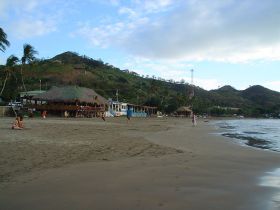 interesting because we are one of the few countries that has two main oceans. The bays of our coastal areas are bathed by the Pacific Ocean and by the Caribbean in the eastern part of the country, and we have about 900 kilometers (560 miles) of coastal areas on both sides together, which is mainly still virgin. We still do not have big hotel chains on our coastal zones. We have many small hotels in those areas that have started to be developed.
interesting because we are one of the few countries that has two main oceans. The bays of our coastal areas are bathed by the Pacific Ocean and by the Caribbean in the eastern part of the country, and we have about 900 kilometers (560 miles) of coastal areas on both sides together, which is mainly still virgin. We still do not have big hotel chains on our coastal zones. We have many small hotels in those areas that have started to be developed.
 country, even though we do not have very high peaks compared to other places like Guatemala. We do, however, have mountains, which have the advantage of being a little bit cooler the higher you go.
country, even though we do not have very high peaks compared to other places like Guatemala. We do, however, have mountains, which have the advantage of being a little bit cooler the higher you go.In the Pacific coast of Nicaragua we have the volcanic mountain range, which starts in the northern part of the country and ends at the lake, in Ometepe Island, which was formed by two volcanoes. Most of the volanoes are dormant, but a few are still active, so it is very interesting for those adventurous people who want to learn about volcanoes, and do hiking on them, etc.
The coastal areas of Nicaragua are very
 interesting because we are one of the few countries that has two main oceans. The bays of our coastal areas are bathed by the Pacific Ocean and by the Caribbean in the eastern part of the country, and we have about 900 kilometers (560 miles) of coastal areas on both sides together, which is mainly still virgin. We still do not have big hotel chains on our coastal zones. We have many small hotels in those areas that have started to be developed.
interesting because we are one of the few countries that has two main oceans. The bays of our coastal areas are bathed by the Pacific Ocean and by the Caribbean in the eastern part of the country, and we have about 900 kilometers (560 miles) of coastal areas on both sides together, which is mainly still virgin. We still do not have big hotel chains on our coastal zones. We have many small hotels in those areas that have started to be developed. We have a lot of reserves in this country 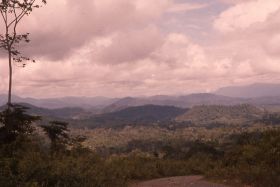 and Nicaragua has the biggest natural forest in Central America, which is till protected—we call it the Amazon of Central America, because after the Amazon, it is the biggest reserve in the region. It is called Bosawas Biosphere Reserve.
and Nicaragua has the biggest natural forest in Central America, which is till protected—we call it the Amazon of Central America, because after the Amazon, it is the biggest reserve in the region. It is called Bosawas Biosphere Reserve.
Another very important natural reserve, which is in the region of the San Juan River and the boarder with Costa Rica in the southern part of the Caribbean area is called Indio Maiz Biological Reserve (“Indian Corn”). Both Bosawas and Indio Maiz are biosphere reserves, as declared by UNESCO.
Also the lake is an iconic, very important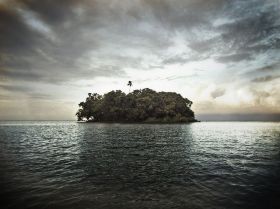 place in the country, because Lake Nicaragua is one of the 10 biggest lakes in the world, and the only one that has fresh water sharks. (In Nicaragua, you will hear Lake Nicaragua referred to as Lake Cocibolca, which is its indigenous name).
place in the country, because Lake Nicaragua is one of the 10 biggest lakes in the world, and the only one that has fresh water sharks. (In Nicaragua, you will hear Lake Nicaragua referred to as Lake Cocibolca, which is its indigenous name).
 and Nicaragua has the biggest natural forest in Central America, which is till protected—we call it the Amazon of Central America, because after the Amazon, it is the biggest reserve in the region. It is called Bosawas Biosphere Reserve.
and Nicaragua has the biggest natural forest in Central America, which is till protected—we call it the Amazon of Central America, because after the Amazon, it is the biggest reserve in the region. It is called Bosawas Biosphere Reserve.Another very important natural reserve, which is in the region of the San Juan River and the boarder with Costa Rica in the southern part of the Caribbean area is called Indio Maiz Biological Reserve (“Indian Corn”). Both Bosawas and Indio Maiz are biosphere reserves, as declared by UNESCO.
Also the lake is an iconic, very important
 place in the country, because Lake Nicaragua is one of the 10 biggest lakes in the world, and the only one that has fresh water sharks. (In Nicaragua, you will hear Lake Nicaragua referred to as Lake Cocibolca, which is its indigenous name).
place in the country, because Lake Nicaragua is one of the 10 biggest lakes in the world, and the only one that has fresh water sharks. (In Nicaragua, you will hear Lake Nicaragua referred to as Lake Cocibolca, which is its indigenous name). The biggest island in the world on a fresh water lake is also on Lake Nicaragua-- Ometepe Island, which is made of two volcanoes, one active and the other inactive. The inactive volcano is called Maderas Volcano, which is a natural reserve and protected as well.
Then we have the San Juan River in the southern part of the country, which is also a beautiful region of the country. It is full of stories of pirates and history like Cornelius Vanderbilt and the transit route that so many Americans used during those times, where Mark Twain wrote beautiful stories about Nicaragua and a wonderful river, as well as where the Spaniards built a castle to protect themselves from the pirates in Colonial times. Pirate Morgan used the San Juan River, and the legends say (although this is disputed) that it was in this area that Lord Nelson lost his eye.
In the central part of Nicaragua is the region of Chontales where much of the cattle in Nicaragua are raised. Nicaragua exports a lot of meat (including to the US), most of which comes from this region. Boaco and Chontales are the two main cities in this area.
Then we have the San Juan River in the southern part of the country, which is also a beautiful region of the country. It is full of stories of pirates and history like Cornelius Vanderbilt and the transit route that so many Americans used during those times, where Mark Twain wrote beautiful stories about Nicaragua and a wonderful river, as well as where the Spaniards built a castle to protect themselves from the pirates in Colonial times. Pirate Morgan used the San Juan River, and the legends say (although this is disputed) that it was in this area that Lord Nelson lost his eye.
In the central part of Nicaragua is the region of Chontales where much of the cattle in Nicaragua are raised. Nicaragua exports a lot of meat (including to the US), most of which comes from this region. Boaco and Chontales are the two main cities in this area.
Posted July 9, 2014
Carlos Roman Gutierrez Solis - Casa Granada Properties
.jpg) Nicaragua is called "Tierra de Lagos y Volcanes" (Land of Lakes and Volcanoes). The country has beautiful mountains, lagoons, lakes, and hills. There are a lot of beaches.
Nicaragua is called "Tierra de Lagos y Volcanes" (Land of Lakes and Volcanoes). The country has beautiful mountains, lagoons, lakes, and hills. There are a lot of beaches. The northern part of Nicaragua; Matagalpa, Jinotega, and Estelí, are the most beautiful and amazing areas in the country because the weather is cold, the air is fresh, and they have mountains.
Visitors of Nicaragua can easily switch...
.jpg) Nicaragua is called "Tierra de Lagos y Volcanes" (Land of Lakes and Volcanoes). The country has beautiful mountains, lagoons, lakes, and hills. There are a lot of beaches.
Nicaragua is called "Tierra de Lagos y Volcanes" (Land of Lakes and Volcanoes). The country has beautiful mountains, lagoons, lakes, and hills. There are a lot of beaches. The northern part of Nicaragua; Matagalpa, Jinotega, and Estelí, are the most beautiful and amazing areas in the country because the weather is cold, the air is fresh, and they have mountains.
Visitors of Nicaragua can easily switch from the mountainous areas in the northern and central areas all the way down to the beaches of San Juan del Sur.
My job is amazing because I can go back and forth to San Juan del Sur, which is two hours away from my city, Granada. If I want to go all the way up to the mountainous areas, I can do it in the same day.
It's easy to drive to different areas and the GPS works perfectly. Waze, a mobile phone application, works everywhere in Nicaragua as long as you have mobile Internet service, in which case, the app tells you exactly the distance you would be traveling and how long it will take you.
There are a number of active volcanoes in Nicaragua such as in León, Ometepe, Concepción, and Masaya. There are also inactive volcanoes. Nicaragua is part of the volcano line that comes from Mexico. From the south to the north of the country is a line of volcanoes.
I have been to Masaya, Ometepe, and León. These are traditional types of volcanoes with high peaks.
Ometepe Island is a beautiful place because you have two volcanoes in the island and has postcard views.
One of the volcanoes in Granada is the Mombacho volcano, which is so beautiful and majestic.
The volcano that is active right now is the one in Masaya and you can see lava when you hike up to the crater. There is a long line of people to view the lava. This volcano is a big tourist destination.
Nicaragua has all types of beaches open for everyone, developed and undeveloped. There are white sand and dark colored sand beaches. There are also a lot of bays in the country. San Juan del Sur is beautiful because there are a lot of bays in this area with some spots where people can surf. There are also very basic beaches where you cannot surf and are rocky, but nice like La Boquita and Casares. There are also the beaches in León: Playa Hermosa, Montelimar, Guasacate, and Playa El Coco.
El Astillero Beach is one of the most beautiful places in Nicaragua.
There are two main lakes in Granada; the bigger Lake Granada and the smaller Lake Nicaragua. Unfortunately, both these lakes are polluted, but the local government is trying their best to clean the lakes.
There is also Laguna de Apoyo, which is one of the most pristine places to go in Nicaragua. The water is clean and the scenery is beautiful when it's green. Laguna de Apoyo is a very safe place to go, which is why expats love to go here.
Lago de Apanás is an artificial lake close to Matagalpa. It has beautiful panoramic views. People love to visit this lake because of the good weather and wide open beautiful spaces.
Nicaragua has waterfalls on the Atlantic Ocean side. There are also some in Matagalpa, Jinotega, and Estelí. Salto de Estanzuela is a very famous waterfall. From the city of Somoto all the way to the most northern part of Nicaragua are very nice, basic places.
El Cañón de Somoto (Somoto Canyon) is another place where you can find a lot of waterfalls. Here you can go river kayaking, which is very nice.
There are a lot more cities in Nicaragua that you can explore. These cities may not have a lot of activities for expats, but people have started to explore these areas. I am surprised by the number of Americans who live in these cities.
Rainforests can be found mostly in the northern and Atlantic / Caribbean parts of Nicaragua, which gets a lot more rain; places such as Puerto Cabezas and Rio San Juan. These are far away and the roads to these places are not that good.
(Masaya volcano's crater, Nicaragua, pictured. )
Posted October 26, 2017


